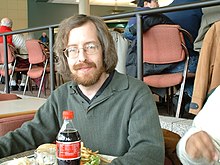Michael R. Douglas: Difference between revisions
Units/dates/other |
picture added (taken by me) |
||
| Line 1: | Line 1: | ||
[[Image:Michael-Douglas-at-Rutgers.JPG|thumb|Michael Douglas at Rutgers University]] |
|||
'''[[Michael R. Douglas]]''' (1961-) is an [[United States|American]] [[theoretical physicist]] and [[professor]] at [[Rutgers University]]. He is a leading researcher in [[superstring theory]]. |
'''[[Michael R. Douglas]]''' (1961-) is an [[United States|American]] [[theoretical physicist]] and [[professor]] at [[Rutgers University]]. He is a leading researcher in [[superstring theory]]. |
||
Revision as of 17:45, 12 October 2008

Michael R. Douglas (1961-) is an American theoretical physicist and professor at Rutgers University. He is a leading researcher in superstring theory.
Michael R. Douglas was born in Baton Rouge, Louisiana, the son of Nancy and Ronald G. Douglas, a mathematician specializing in operator algebras. He received his bachelor's degree in physics from Harvard University. He then went to Caltech and received a Ph.D. in physics in 1988 under John Schwarz, one of the inventors of superstring theory.
After completing his Ph.D., Douglas was a postdoc at the University of Chicago for a year, then moved to Rutgers University in 1989 with Dan Friedan and Steve Shenker to help start the New High Energy Theory Center (NHETC). He was promoted to assistant professor in 1990 but spent his first year visiting the Ecole Normale Superieure and the MIT Artificial Intelligence Laboratory. He became an associate professor at Rutgers in 1995, and left for a year in 1997-1998 to take up a permanent position at the Institut des Hautes Etudes Scientifiques. He then returned to Rutgers and in 2000 became the director of the NHETC.
Douglas is best known for the development of matrix models (the first nonperturbative formulations of string theory), for his work on Dirichlet branes and on noncommutative geometry in string theory, and for the development of the statistical approach to string phenomenology. He was on the team (led by Gerald J. Sussman) that built the Digital Orrery, a special-purpose computer for computations in celestial mechanics, and maintains an active interest in computer science. He is also very active in organizing schools and workshops, for example at Les Houches, Cargese, and the KITP Santa Barbara.
Douglas received the 2000 Sackler Prize in theoretical physics, holds a Louis Michel Visiting Professorship at the Institut des Hautes Etudes Scientifiques, and has been a Gordon Moore Visiting Scholar at Caltech, and a Clay Mathematics Institute Mathematical Emissary.
Douglas is married and has two children. His wife, Nina Ilieva Douglas, is an author and illustrator of children's books.
In 2008, Douglas moved from Rutgers to become the first permanent member of the Simons Center for Geometry and Physics, a research center at Stony Brook University.
